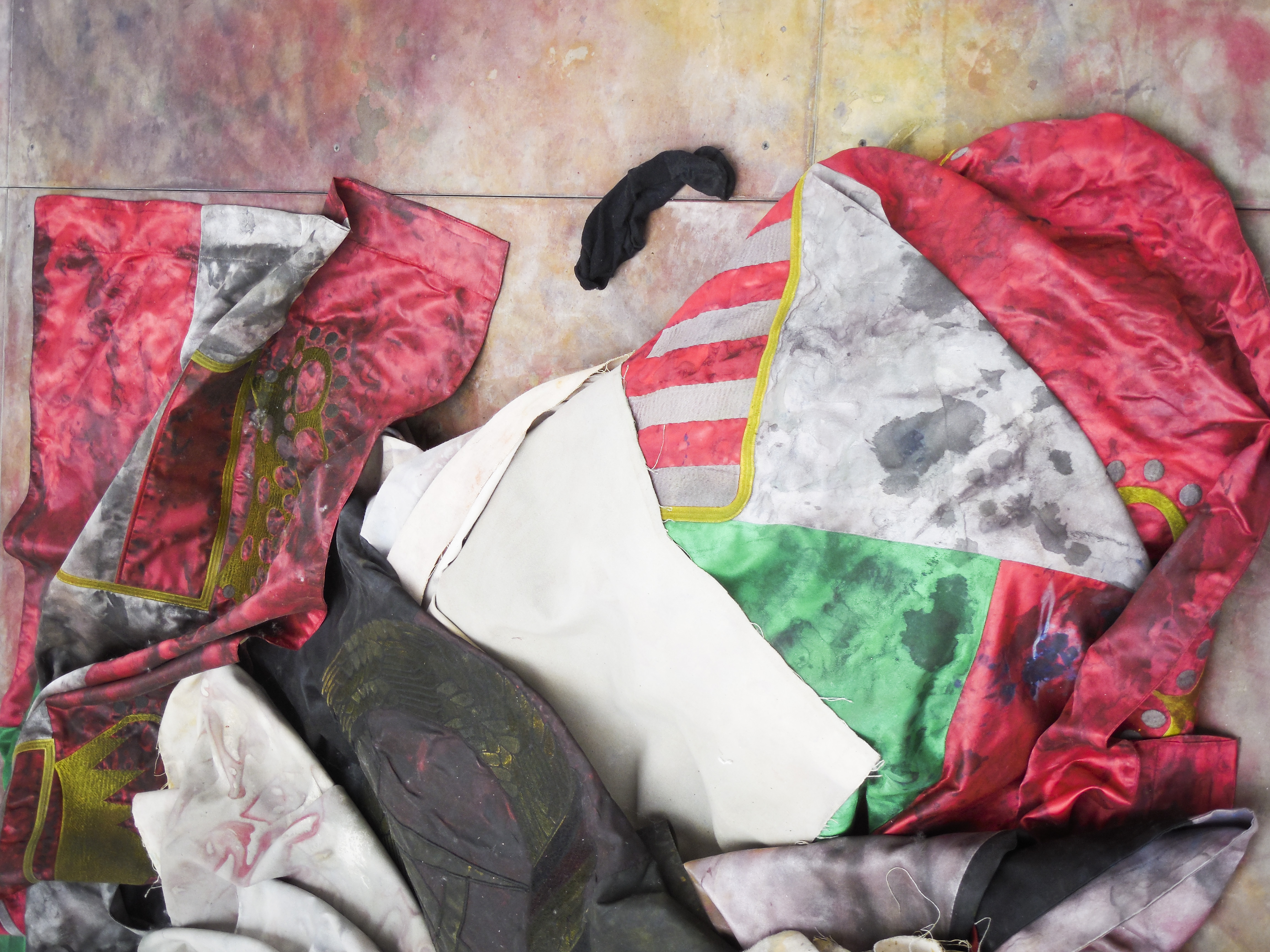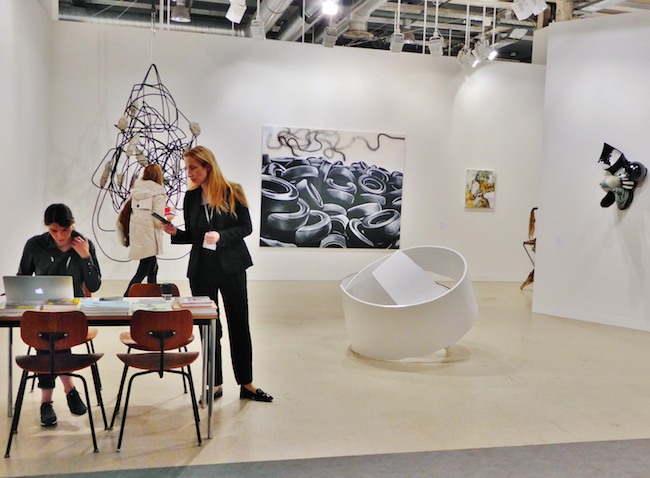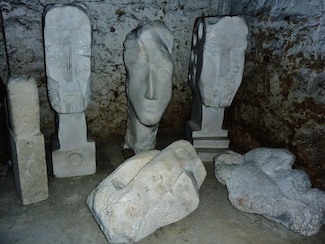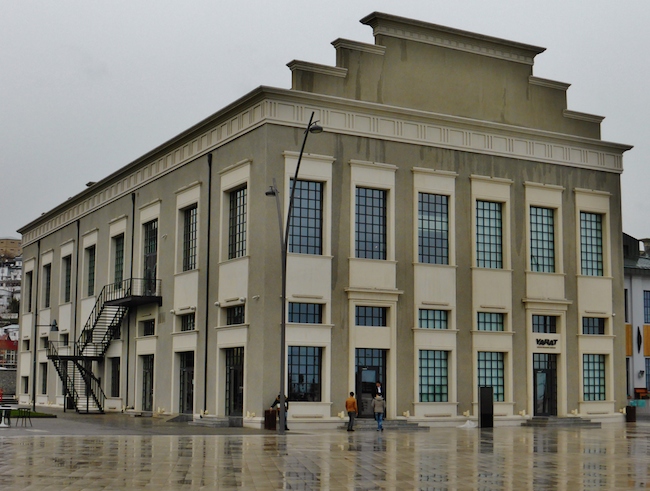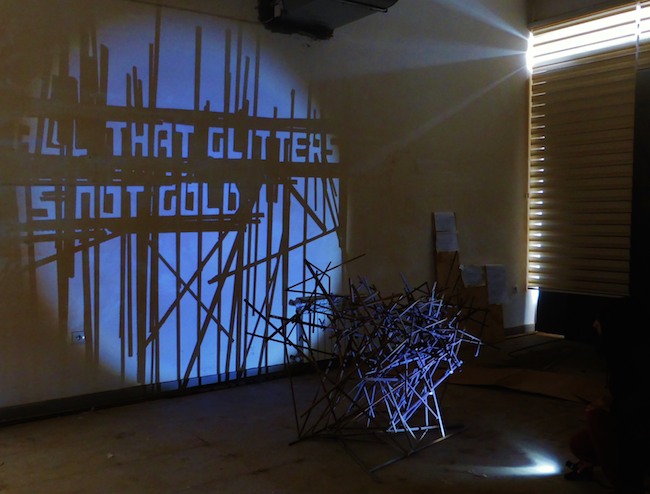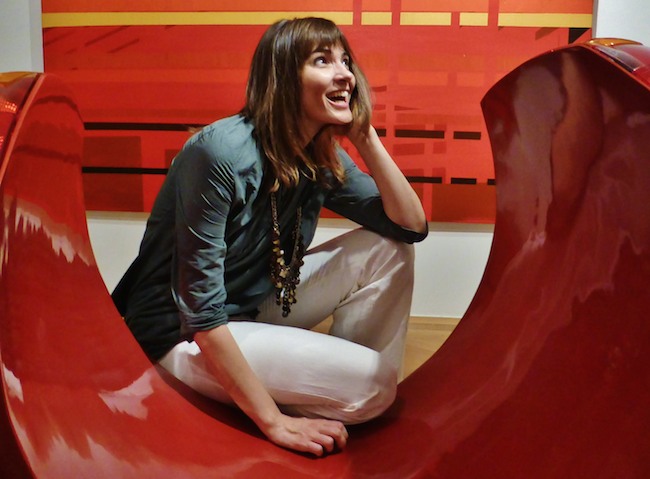by Simon Hewitt
How is East European art developing from a Western European point of view? Where do Western collectors look when they hunt in East? What is the next ‘big thing’ for Western collectors to look for in Eastern Europe? Which countries can become a market focus – and why?
Those were the questions fired at me by Arterritory’s Agnese Civle.
‘Get back to me in five minutes!’ she commanded.
Only joking, but I probably could have done:
Dear Agnese! Westerners are ignorant about Eastern Europe (in general) and East European art (in particular). Western Collectors are indifferent to Eastern Europe’s Next Big Artistic Thing. The only Big Thing that Westerners hunt for in Eastern Europe is a Cheap Hangover. They are incapable of focusing on their own beer-glass, let alone the cultural differences between Slovenia and Slovakia or Kosovo and Kaliningrad.
But better not be flippant, so I contacted some respected American contemporary art dealers instead.
‘I honestly know very little about recent art from Eastern Europe’ said one.
‘I have no idea about any of this’ frowned another.
‘My knowledge of Eastern European Art is very poor’ admitted a third.
‘Sorry, but I can’t help you’ declared the fourth.
There is, though, at least one Western contemporary art dealer who keeps a close eye on the East European art market: Vienna’s Hans Knoll, who has a subsidiary gallery in Budapest and regularly chaperones Western-based ‘Eastern European Collectors’ around studios and galleries in the region – this year to Hungary, Romania, Russia (twice), Poland (twice) and Slovakia (twice). His EEC group has its own web-page, packed with background information from local curators.
Could Hans provide some input?
‘Certainly’ he agreed, then paused, then added: ‘I’m not sure that many Western collectors are hunting for art in Eastern Europe. People around the world tend to be mainly interested in the art of their own country.’
So I turned to the Georgian-born, Paris-based Shalva Khakhanashvili who – as founder of Caravansarai Artistic Exchanges, designed to connect East and West – regularly criss-crosses Europe.
‘I see very few collectors who buy artists from Eastern Europe’ he replied mournfully.
This was threatening to turn into a shortish article.
‘The organizers of Vienna Contemporary say Romanian art is top right now’ suggested Agnese helpfully.
Vienna Contemporary – or rather its predecessor, the Vienna Fair – had a special section devoted to Romanian galleries in 2014.
Its Artistic Director, Christina Steinbrecher, is one of the most informed observers of the East European art scene – having piloted the now-defunct Art Moskva before assuming her current role.
‘Western collectors can be interested in art from Eastern Europe’ began Christina encouragingly. ‘But, even for many experienced collectors, East European art is still unknown and the artists from the region are not – or not yet – on their radar.’
Oh.
‘When it comes to the few who are interested,’ I prodded, ‘what attracts them?’
‘I think it’s a combination of technical skill and post-Soviet Zeitgeist’ replied Christina. ‘Many Eastern European artists have, at least partially, a classical art education which is reflected in their work. Painting and sculpture are generally of very good quality. And we see a duality in the contemporary art scene – the rebels from the end of Communism, and the younger generation detached from this political heritage. This duality creates a very inspiring environment.’
Diana Stomienė, Director of Art Vilnius, agrees with Steinbrecher that ‘the West is interested in the way artists from ex-Soviet countries bring their past into art’ – and that ‘for the West, this is still an undiscovered world.’ She cites Kaspars Podnieks (Latvia), Merike Estna (Estonia) and Žilvinas Kempinas (Lithuania) among Eastern Europe’s most exciting artists.

Art Vilnius 2016
Dovilė Bilkštienė: Washing
Other Lithuanian artists to catch the eye at Art Vilnius this year included Kęstutis Svirnelis, Dovilė Bilkštienė, Linas Blažiūnas, Rodion Petroff and Jolanta Šmidtienė. Latvian artists were headed by Madara Gulbis (at Agija Sūna) and Aija Zariņa (at Tifāna). The gallery scene in Riga remains lively despite Latvia’s economic woes and, although small and eccentric, the Art Riga fair – pioneered with such zeal by Dags Vidulejs and Gaļina Maksimova – will defy the odds to run for a third consecutive year this November. Latvia’s €30,000 Purvītis Prize for domestic artists is one of the most generous in Europe, although little is done to publicize it (effective PR is a major problem for East European art organizations, with the exception of the lavishly funded Pinchuk Centre in Kiev).
Throw in the tireless participation of Tallin’s Temnikova & Kasela Gallery in international fairs, and you could say the Baltic art scene is swimming along nicely: we are talking, after all, about a region with a total population not much bigger than St Petersburg’s (whose contemporary gallery scene has virtually disintegrated).
Even so, I doubt that the Baltic States can be the next ‘big thing’ to look for in Eastern Europe – or that Latvia, Lithuania or Estonia can ‘become a market focus.
When I asked Christina Steinbrecher to name Eastern Europe’s most exciting artists, she reeled off 43 names from 15 different countries. Some, admittedly, are not exactly Next Year’s Thing: Bulgaria’s Nedko Solakov, Russia’s Pavel Pepperstein, Poland’s Piotr Uklański, Romania’s Dan Perjovschi and Belgrade-born Marina Abramović have all been around for quite a time.
Art Vilnius 2016
Kęstutis Svirnelis: Something In the Air
But Christina also suggested Bosnia’s Mladen Miljanović, Croatia’s Damir Ocko, Czechia’s Eva Kotátková, Slovenia’s Jasmina Cibic and Kosovo’s Flaka Haliti as Eastern Europe’s ‘ones to watch.’
For the purposes of this article ‘Eastern Europe’ comprises the former Warsaw Pact countries (including those from Central Europe) and ex-territories of the Soviet Union, including the Southern Caucasus. It does not include Greece, which narrowly escaped Communist takeover in 1945; or Turkey – keen to join the E.U. and regularly present in European soccer tournaments.
Most of these countries have a Communist heritage of Academic training that places greater importance on technical skill than originality; a gallery scene that is modest by Western standards; and very few inhabitants who collect contemporary art.
Historically and culturally, however, it is restrictive and misleading to define East European art solely in a post-Communist context. Eastern Europe is above all a region of cultural crossover and constant flux.
Until World War I the twenty or so countries which now make up Eastern Europe were united under the Habsburg, Tsarist, and Ottoman Empires; the Polish cities of Poznan, Wrocław and Gdansk were German, as was today’s Russian enclave of Kaliningrad.
Only one West European country has seen its borders significantly altered during the last 100 years: Germany. Only one country in Eastern Europe has virtually the same borders today as it did 100 years ago: Albania.
Few countries epitomize cultural mélange more than Romania. It was ruled by the Turks until 1878; acquired much of Hungary, including the celebrated artists’ town of Nagybánya (Baia Mare), after World War I; and its central region of Transylvania was populated by German-speaking ‘Saxons’ for 800 years (one of whom, Klaus Iohannis, is now Romania’s President).
Romanian contemporary art has enjoyed a steady rise to prominence since its first gallery, H’Art, was founded in 2002 in Bucharest and, unlike many East European countries, it also has a thriving art scene in the regions – notably in Iași, Timișoara (which launched its own Biennale last Autumn), and Cluj (formerly the Hungarian city of Kolozsvár).
Plan B, founded in Cluj in 2005, swiftly became Romania’s pre-eminent gallery – propelled by the country’s most successful artist Adrian Ghenie who, after being energetically promoted by Pace Gallery, has become the only East European artist to be ranked among the world’s 200 top-selling artists. Plan B opened a second gallery in Berlin in 2008, and helped launch the Fabrica de Pensul in Cluj – a converted paint-brush factory that now hosts three galleries and 26 artist’s studios – in 2009. Plan B take part in Art Basel and Gallery Director Mihai Popp curated a Ghenie solo show for the Romanian Pavilion at the 2015 Venice Biennale.
Bucharest has responded dynamically to Cluj’s provincial challenge. New galleries (most recently Eastwards Prospectus and Mobius) continue to spring up, while others – like Anca Poterasu, Ivan or 418 – have steadily increased their presence on the Western fairs circuit. Bucharest’s Biennale ran this Spring for the seventh time, and its White Night of Galleries (September 30) is celebrating its 10th edition this year by being extended to other Romanian cities.
All this buzz – fuelled by a recent economic upturn and the 2014 election of a President determined to clean up corruption – is mirrored by burgeoning interest in Romanian art abroad.
Veteran Belgian dealer Jan de Maere – who owns property in Romania – shows several Romanian artists at the MB-XL Gallery he co-founded in the Brussels last year, notably Transylvania’s powerful graphic artist Tara von Neudorf and Cluj-born András Szabó, who obtains unique chiaroscuro detail by scratching white plastic covered in black ink. Ciprian Muresan was the only East European artist showcased in the Art Unlimited section of this year’s Art Basel, while his iconic work Communism Never Happened leads a strong Romanian contribution to the Ludwig Museum’s 25th anniversary show in Budapest, charting its acquisitions of East European art since 1989 (through September 25).
Rampant Romania
Belu-Simion Făinaru: Rose Of Nothingness from Mapping Bucharest at the Vienna MAK
Last Autumn Mapping Bucharest, an historical overview of Romanian contemporary art, was shown at the MAK as part of the Vienna Biennale while, back in Bucharest, the extensive collection of the MNAC (National Museum of Contemporary Art) was given a rare airing alongside a majestic Mircea Suciu solo show.
Last October I had the pleasure of curating the debut show at the spacious, smartly appointed Mobius Gallery: Simulacrum, an array of 12 paintings by the Chişinău-born, Bucharest-based Roman Tolici – one of the finest artists in Eastern Europe.
Why Tolici remains unknown in the West makes an interesting case-study.
Mobius was co-founded by his girlfriend Roxana Gamart, who is naturally keen for Tolici to be the gallery’s flagship artist.
The chivalrous Tolici is in a tricky position. So far he has put his own interests on the back-burner – even though he clearly needs, and deserves, a gallery with more extensive international contacts and promotional expertise.
Rampant Romania
Preparing the Roman Tolici exhibition Simulacrum at Mobius Gallery
Despite commissioning texts, Mobius failed to publish a catalogue to the Simulacrum show to help them promote Tolici among dealers from London, Paris or New York – where his works would grace any gallery. Instead, they looked east, and sent one work from Simulacrum to a bizarre Romanian group-show in Moscow curated by rival Bucharest dealer Dan Popescu: the first in a series of exhibitions at Triumph Gallery bombastically purporting to ‘showcase the current art scene of different countries.’ The series bears the imperialistic title Extension and trumpets the Kremlin message that it’s business as usual for Russia despite international sanctions.
Dispatching Tolici’s work to Moscow was politically naïve and, in terms of commercial strategy, made little sense. Moscow’s nascent contemporary art scene was nipped in the bud by the financial crisis of 2008/9, then clobbered by the collapse of the ruble in the wake of the invasions of Crimea and Eastern Ukraine. Triumph are one of the city’s biggest galleries yet, despite representing AES+F and Recycle, have never been admitted to a top-flight international fair – ‘because,’ claims boss Dima Hankin, ‘we’re Russian.’

Russia in the red
Tanya Akhmetgalieva: Effect of Invasion (2013)
As the region’s largest and richest country, Russia should be the powerhouse the East European contemporary art market badly needs. Yet it has become internationally toxic. London-based collector Igor Tsukanov’s next blockbuster show at the Saatchi Gallery, in 2017, will focus on Russian Actionism – but he is struggling to decide what to call it as ‘we are trying to avoid the word Russian…. Any association with Russia is strongly negative right now.’
Not so long ago foreign dealers were enticed by the energy of the Moscow scene – epitomized by the Swiss-organized Moscow World Art Fair, which ran 2004-08, with an increasing emphasis on contemporary art. Now the Moscow market, in the words of the city’s peripatetic artist/curator Dima Goryachkin, is ‘half-dead.’ Coverage of art in the media has plummeted: not a single Russian journalist visited the Moscow gallery Everything Is Art (which represents Goryachkin) at Scope Basel this June – even though it was the only Russian art gallery in the city during Art Basel week.
After six editions, the once-vibrant Moscow Biennale has collapsed. Perhaps a new Moscow Triennale, to be launched by Dasha Zhukova in 2017, can propel Russian contemporary art into the international spotlight – but I doubt it.
The country’s most adventurous dealer, Marat Guelman, was kicked out of his Moscow gallery last Autumn for annoying the Kremlin. The artist and writer Maxim Kantor, an outspoken critic of the Russia’s current ownership, has been forced to emigrate after receiving death threats. To the consternation of Moscow’s artistic community, the National Centre for Contemporary Art has just been placed under government control – with a military-trained apparatchik, Sergei Perov, installed as boss.
St Petersburg curator Anastasia Blokhina – current head of YAY Gallery in Baku – believes that, ‘due to the enormous size of the country, Russia just keeps on producing new talents, no matter how hard the government tries to discourage them.’ Look no further than the show of Russian contemporary art at London’s Pushkin House (through August 3), starring the ingenious work of two provincial 32 year-olds: Tanya Akhmetaglieva from Siberia, with her use of yarn and embroidery; and Ilya Grishaev from Perm, with his textured paper cut-outs. But in Russia I have come across numerous brilliant artists at non-commercial, out-of-the-way venues – Anna Orekhova, Katerina Popushoy and Elena Slobtseva, to name but three – who, I fear, may never achieve meaningful gallery representation.
For the moment these artists remain in Russia. Many of their colleagues have quit The Motherland because of its stifling political climate and economic meltdown.
*
The main goal of Eastern European artists, as Shalva Khakhanashvili puts it, is to ‘find Western collectors interested in their work and be present in a gallery in a Western capital that will show and sell their works.’
There are so many East European artists living and working abroad that – feels Gaudenz B. Ruf, a vigorous backer of Bulgarian art after his stint in the country as Swiss Ambassador – it is ‘becoming increasingly difficult to distinguish national features.’
Albania’s Anri Sala, for instance, represented France at the 2013 Venice Biennale.
Of course, many ambitious young East Europeans – whether plumbers, waiters, dentists, car mechanics or computer analysts – have left their countries for better living standards in the West. East European artists had begun to settle in the West well before 1990; since the collapse of Communism that trickle has become a flood.
Does their art necessarily lose its ‘national’ characteristics as a result?
Probably, to some extent.
Is that a bad thing?
The glib answer would be No: Art Is Universal. But I’m not so sure.
Stylistic homogeneity has facilitated the recognizability, promotability and popularity of Romania’s tight-knit School of Cluj – arguably the greatest success story of East European art in recent years.
But it is not just East European artists who have moved to the West. East European galleries have too – with Berlin their prime destination. These days Plan B from Cluj, Gregor Podnar from Ljublana, Jiri Svestka from Prague and Żak | Branicka from Cracov all do most or all of their business in the German capital.
Montenegro dealer Gayo Vojdovic maintains a gallery in Podgorica, but operates primarily from Rome. Three years ago, deeming East European artists insufficiently commercial, he funded Chinese artists to come and paint in Montenegro with a view to selling whatever they produced. Vojdovic has also staged Summer shows at Porto Montenegro, the luxury yacht marina on the Adriatic Coast – where London’s Mead Carney Gallery opened a new gallery space in 2014. To show Montenegran or East European artists? No. To show Damien Hirst, Marc Quinn and Gerhard Richter.
Some of East Europe’s most dynamic galleries look far further afield – starting with Miami, New York or Hong Kong. LambdaLambdaLambda from Priština took part in the Material Art Fair in Mexico City this February. Soda Gallery from Bratislava showed at Art Fair Tokyo this May. Russia’s most dynamic gallery on the international scene, 11-12, opened a subsidiary in Singapore in 2012.
East European galleries are forced to cast their net far and wide because they do little business on home turf – and there is no single art fair that provides a comprehensive overview of East European Art.
Art Vilnius hosted 56 galleries this June: 28 were from Lithuania, 21 from other East European countries. Last October’s Art Market Budapest featured 67 galleries: 27 from Hungary, 22 from other East European countries. In 2015 Vienna Contemporary hosted 108 galleries: 48 from Austria/Germany, 27 from East European countries.
Fewer than 4% of the 500 galleries present at this year’s Art Basel and its three main satellite fairs (Liste, Scope and Volta) were from Eastern Europe.
As Western Europe’s biggest non-commercial showcase, the Venice Biennale offers a more extensive overview thanks to its system of national pavilions. Although these can propel ‘unfamiliar’ countries into the spotlight, their emphasis on installations and large-scale artworks – overseen by a curator whose approach is often conceptual – is geared more to institutions than private collectors.
Auctions might seem to be another important way of fostering interest in East European art – after all, Contemporary Art is the most lucrative area of the global auction business.
But the presence of East European Art at auction is minimal. Although Sotheby’s have just announced plans to launch regular sales of African Contemporary Art, the closest attention they – or any other international auction firm – pay to East European art are sporadic sales in London entitledContemporary East. The latest of these, on June 7, had 60 works from Russia interspersed with a higgledy-piggledy array of 60 works in various media (above all photography) by artists from Hungary, Poland, Romania, Yugoslavia and Czechoslovakia.
I use old country names because only six of these works dated from after 1990. One was Touch, painted by Hungary’s Attila Szücs in 2016 and consigned by his Budapest gallerist Erika Deák, who ‘wanted to show our foreign collectors the best available work here.’
It sold to a ‘new collector from outside of EU’ for £16,250 against an estimate of £5,000-7,000 – so Deák will have felt herself justified. But, if East European galleries opt to sell brand new works at auction, what does it say about their ability to attract international attention themselves?
The most extensive selection of Eastern European art is to be found on the Saatchi Art website – the ‘world’s largest on-line art gallery’ with 370,000 works up for grabs. But buying art viewed only on computer is hardly the favoured approach of serious collectors. Nor does an internet supermarket constitute a prestigious showcase for artists, however desperate they may be to reach prospective new clients.
How many talented artists are languishing in East European oblivion?
The only way to find out is to visit Eastern Europe and hunt around. Not a very practical scenario for today’s average Western collector – few of whom, I fear, are inclined to adopt the approach of Switzerland’s Uli Sigg, the West’s leading collector of Chinese art, who has visited more than 1,000 studios over the last 20 years. ‘It is not sufficient just to see the product or buy from a gallery!’ he trumpets. ‘Collectors must go and see the artists!’
Before 1990 inveterate Western collectors like Norton Dodge or Peter Ludwig enjoyed the thrill of buying contemporary art behind the Iron Curtain. When the collapse of the Soviet bloc made East European art more readily accessible, there was a ‘craving of the Western art market for new territories, fresh faces and original visual input,’ remembers the German-based Bulgarian curator Ilina Koralova. Now, though, ‘for good or for bad, those times are behind us’ she sighs.
Contemporary art in Eastern Europe received a short-lived boost in the 1990s from George Soros, who launched a Soros Center for Contemporary Art in 16 countries. But the Hungarian-born American philanthropist ended his funding in 1999, when his centres were transformed into independent bodies of limited clout grouped under the ineffectual ‘International Contemporary Art Network.’
Stars of Central Europe
Foksal at Art Basel 2016
At around the same time, international attention shifted to Chinese contemporary art – powering its market value to stratospheric heights by 2008.
‘Today East European artists and galleries are not very visible to international collectors,’ as Christina Steinbrecher puts it. ‘And they are not as exotic as emerging artists from Asia or Latin America.’ Or South Africa or Aboriginal Australia.
Although ‘some big galleries like Pace and Thaddaeus Ropac have picked up on East European artists and had marvellous success’ (Steinbrecher), few Western dealers sell art from Eastern Europe – which offers little prospect of a swift return and is probably one of the world’s least-known regions for contemporary art.
Yet there is plenty going on in Eastern Europe. Here are just two events you may never have heard of.
Far-Flung Festivals
Raya Georgieva: Distance (2008) at Contempo – Varna
Kazakh-Born, Paris-Based Ada Yu: Installation at Caravan Art Forum – Kutaisi
This May Shalva Khakhanashvili staged an ‘International Art Forum’ in the Georgian city of Kutaisi (population 200,000) with talks, debates, street art and gallery exhibitions featuring artists from Georgia, Russia, Latvia, Poland and Kazakhstan (as well as France, Turkey and Venezuela).
Georgian President Giorgi Margvelashvili opened the event and the country’s superstar opera-singer Anita Rachvelishvili headlined the closing concert.
This September sees the 8th edition of the Contempo International Contemporary Art Festival in Varna on Bulgaria’s Black Sea Coast – a modest city of 330,000 with a surprisingly buoyant gallery scene.Contempo is run on a shoe-string by Dora Doncheva of Bulart Gallery, yet has a programme just as varied and inventive as the Kutaisi forum. This year, showing unwonted PR savvy, the festival has been extended to overlap with the headline-grabbing arrival in Varna of the Black Sea Tall Ships Regatta.
I attended Contempo in 2012 and enjoyed it every bit as much as the event in Kutaisi. Such bold initiatives merit long-term success. Refreshingly – as so often in Eastern Europe – their approach to contemporary art is based more on passion than commercial logic.
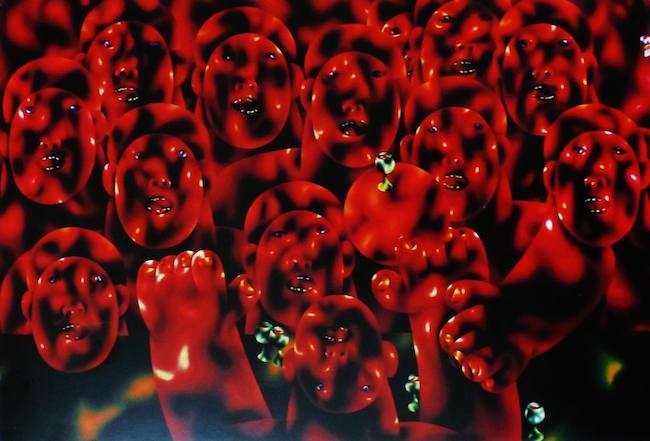
Russia in the red
Oleg Tselkov: The Last Supper (1970)
I had a startling illustration of Western ignorance of East European art when I met members of Tate Modern’s Eastern Europe Acquisitions Committee in Moscow in 2013, at a presentation of Oleg Tselkov’sLast Supper (1970) – one of the most powerful paintings of the post-war era. The dozen or so middle-aged Britons who made up the Tate’s East European Committee hrrmphed knowledgeably about the evening’s champagne and caviar, but seemed blissfully ignorant of East European art. They turned down the chance to acquire Tselkov’s masterpiece – despite being offered it for free.
If Western institutions do pay attention to East European artists, it is invariably ones with a long-established reputation. Tate Liverpool were recently pleased to announced the first U.K. retrospective devoted to Poland’s Edward Krasiński, in 2017. He died at the age of 79 back in 2004.
Stars of Central Europe
Foksal at Art Basel – Attila Szűcs: Touch (2016)
The Polish presence in Basel this year was the strongest of any East European country. Foksal and Starmach were at Art Basel itself, while Liste hosted Dawid Radzizweski and Raster – whose stand was awash with glossy leaflets advertising the 2016 Warsaw Gallery Weekend (September 23-25) and its impressive 24 venues.
Ten other Polish galleries, led by Zderzak and Lokal_30, exhibited at this June’s Art Vilnius – from three different cities (Warsaw, Cracov and Poznan). Fair Director Diana Stomienė considers Poland ‘one of the most rapidly developing markets in Central and Eastern Europe, with an impressive contemporary art stage that is not very well-known.’
Her fair also featured displays by the contemporary art centres in Cracov and Gdansk. Polish public collections, points out Hans Knoll, are ‘very open to international exchange – there is even a Ministry programme for selected institutions to buy international art.’
The Polish art scene is helped by the country’s recent economic growth. GDP has risen 18% since 2010, with the economy now the most vibrant in Eastern Europe. GDP in Romania, Czechia and Hungary has grown at about half that rate over the same period. (At the other end of the spectrum, countries formerly in the USSR – led by Ukraine, Moldova and Belarus – have seen their GDP plummet. Ukraine’s exciting art scene – spearheaded by Tsekh Gallery in Kiev and Donetsk’s Izolyatsia Foundation as a sort of government-in-exile – is crippled by the country’s parlous finances.)
Unfortunately, Poland is currently in the grip of an authoritarian, nationalistic regime that is threatening to undermine freedom of cultural expression. The same applies to Hungary, although its contemporary art scene is notably different – with its own contemporary fair (Art Market Budapest) and a gallery set-up confined essentially to the capital.
Hungary is also the only East European member of the Federation of European Art Gallery Associations, whose 2013 Creativity & New Inspiration Award was presented to Budapest gallery-owner Ani Molnár. She has since exhibited at fairs in Vienna, Istanbul, Brussels, Turin, New York, Barcelona and Madrid, but has yet to show in Basel – where not a single Hungarian gallery was to be found at any fair this year, even though galleries like Kisterem and Deák Erika have shown at Basel satellite fairs in the past.
Funding may be one factor in this, strategic choice another. Last year Deák Erika took part in Vienna Contemporary and Arte Fiera Bologna; this year Kisterem participated in Art Cologne and Art Rotterdam. Another Budapest gallery, Várfok, regularly show at Art Karlsruhe. But – although Hungary’s gallery scene is more dynamic than those in Slovakia, Czechia or Slovenia – I don’t get the impression it has kicked on as fast as Romania’s, or has the same scope and potential as Poland’s.
The country doing most to project a dynamic image via contemporary art is Azerbaijan – despite the absence of a domestic gallery network.
Away By the Caspian
Yarat Centre Baku
Its contemporary art scene is dominated by the Yarat Foundation, whose Founder and Creative Director, Aida Mahmudova, is a member of the country’s mega-rich ruling family. Last year Yarat opened a flashy new exhibition centre by the Caspian Sea, and erected a studio building for young artists whose work, in a variety of media, is avidly promoted by Yarat and its commercial arm, YAY Gallery.
YAY have shown in Vienna, Dubai and London – attracting ‘collectors who see up-and-coming artists from an interesting country doing something new,’ in the words of Director Anastasia Blokhina. ‘They also see that our artists are being exhibited all around the world.’
Away By the Caspian
Rashad Alakbarov: All That Glitters (2014)
YAY’s current flag-bearers are Faig Ahmed, with conceptually reinvented rugs and carpets; Farid Rasulov, with intricate carvings based on Islamic patterns; and Rashad Alakbarov, with abstract metal sculptures lit to cast ingenious shadows (often slogans) on a background wall. Blokhina believes their art offers ‘a beautiful mix… halfway between European and Middle Eastern.’
Whether Azerbaijan is more Middle East than Eastern Europe is a matter of opinion – whatever its enthusiasm for the Eurovision Song Contest. It is no coincidence that the fair where YAY sell most is Art Dubai.
Similar geographic uncertainty applies to Kazakhstan. Most of the country is physically in Asia; but its main city, Almaty, was built under the Tsars and looks (and talks) Russian.
Although Kazakhstan’s most famous artistic daughter, Almagul Menlibayeva, has long since joined the artistic jet-set and decamped to Berlin and Amsterdam, Almaty remains a hotbed of artistic talent: Saule Suleimenova, Katya Nikonorova and Kamilla Gabdullina are just some of the artists who leapt off the page when I visited Almaty two years ago.
Unlike their Azeri counterparts, though, there is no State-financed juggernaut to promote them.
Both Azerbaijan and Kazakhstan are dictatorships short on freedom of expression, where political, religious or sexual subjects are taboo – witness the fiasco at the Azeri Pavilion at the 2011 Venice Biennale, when sculptures by Aidan Salakhova were draped in white sheets after offending the sensibilities of the country’s culture minister.
For their 2015 opening Yarat commissioned a monumental installation by Iranian artist Shirin Neshat, consisting of giant photographic portraits of over 50 Azeri citizens, overlaid with calligraphic inscriptions dutifully quoting their love of their country. Propaganda has seldom seemed so shameless – or aesthetic.
State support for contemporary art in some other countries can be virtually insignificant. Bulgaria, for instance, has only been present at the Venice Biennale once in living memory (2007).
Ilina Koralova believes that ‘Bulgarian artists, curators and art critics never developed the sense of community’ needed to pressurize the government into ensuring a Bulgarian presence in Venice or create ‘an adequate contemporary art museum that would enable curators from abroad to gain a comprehensive view of Bulgaria’s current art production.’
It is revealing that Korolova omits galleries from her group of potential lobbyists – and that she considers the role of a contemporary art museum to appeal to foreign curators rather than collectors.
Vienna Contemporary 2015
Punters pour in to focus on Bulgaria
Such indifference to the commercial market remains prevalent in many countries of Eastern Europe: a throw-back to Communism, when artists were effectively régime employees guaranteed commissions, materials and a studio by the State-controlled Artists’ Unions (which continue to peddle visual mediocrity on the fringes of the artworld throughout Eastern Europe).
It took a private initiative for Bulgaria to be the ‘focus country’ of Vienna Contemporary in September 2015. Rather than a cluster of same-country galleries, this focus involved a series of talks about the Bulgarian art scene and a giant display of Bulgarian artworks organized by Sariev Gallery from Plovdiv, in conjunction with curator Vesela Nozharova.
There was inevitable annoyance among other Bulgarian dealers that the display implied that (as one of them put it to me) ‘just one gallery was empowered to represent the whole of Bulgarian contemporary art’ and ‘was not a focus on Bulgaria but a focus on the Sariev Gallery and the circle of artists and curators around them. Good quality artists from outside this circle were not selected.’
Still, it was a welcome initiative, and better than nothing. As Bulgaria’s most active gallery at international fairs, Sariev made logical interlocutors. It might have been preferable, to avoid accusations of bias, if Vienna Contemporary had appointed a non-Bulgarian curator to organize their single-country project. But, supposing a foreign curator with sufficient local knowledge exists, that could have been more costly and logistically complex.
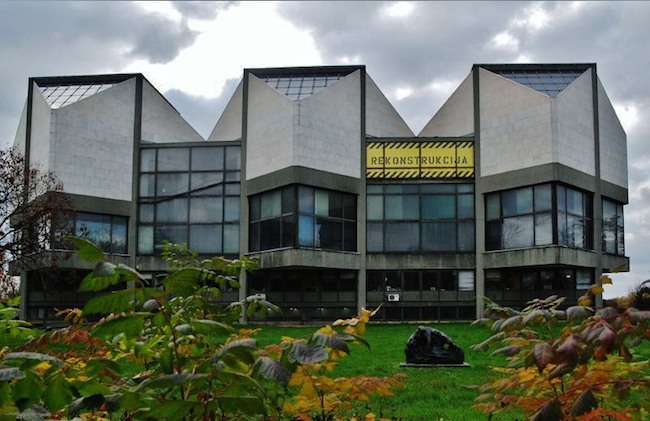
Belgrade Museum of Contemporary Art
Another country where government support for contemporary art appears lacking is Serbia. The Belgrade Museum of Contemporary Art – a striking Modernist building opened in 1965 in a prime riverside location – boasts 5,500m2 of exhibition space and is potentially the top contemporary art venue in the Balkans. But it closed for a renovation in 2007, and its failure to reopen has become a standing international joke. Branka Andjelkovic, Museum Director from 2001-13, blames ‘political élites’ for having ‘no interest in art or culture.’
Yet the young Serbian art contemporary scene is ‘surprisingly vivid and dynamic – a hidden treasure in the heart of Europe’ according to Ksenija Samardžija who, as head of the art association PODR.UM, has promoted the work of over fifty Serbian artists in recent years, and just launched a new commercial gallery, Drina, opposite Belgrade’s Presidential Palace.
If anyone can power Serbia on to the international art stage it could well be the tall, elegant Samardžija, who has the demeanour of a princess – she descends from Balkan aristocracy – yet brings fierce integrity, ferocious national pride and a degree in Art History from Belgrade’s Philosophy Faculty to her tireless efforts to seek out Serbia’s sharpest artists.
‘We must change stereotypes about our country!’ she thunders. ‘The best way is art!’
Ksenija Samardžija with Nikola Kolja Božović’s Fiat Punto Transformed (2011)
Samardžija – who combines her gallery work with an 8-till-4 day-job as Curator of the city’s Kuća Legata Heritage Foundation – plans to start taking part in international fairs, where a Serbian gallery presence is long overdue. True, there were a couple of Serbian exhibitors at last October’s Art Market Budapest – but they were associations, not galleries: the U10 Young Artists’ Space in Belgrade, showcasing outstanding works by Lidija Delić and Marija Sević; and Uncool Project from the small town of Senta.
Another Balkan country to watch is Albania, home to ‘the most vibrant art scene in Eastern Europe’ according to Dimitris Konstantinidis, Director of the Strasbourg-based association Apollonia, founded in 1998 to encourage artistic exchange programmes between West and East. Unlike some of their neighbours, Albanian artists are given political encouragement by one of their own: Prime Minister Edi Rama – whose paintings have been exhibited from Frankfurt to São Paolo and who, as Mayor of Tirana (2000-11), oversaw psychedelic efforts to beautify the pre-fab-drab concrete apartment blocks erected under Enver Hoxha. Albania’s emergence into the international artistic mainstream is reflected by the current staging of Ideals & Artworks from Budapest’s Ludwig Museum at the National Art Gallery in Tirana (until August 14).
Albania at the 56th Venice Biennale
Sandwiched between Serbia and Albania is Europe’s newest state, Kosovo – which has the continent’s youngest average population (ahead of Albania). Priština’s Stacion Centre for Contemporary Art was also present at Art Market Budapest, ‘committed to the advance and emancipation of the contemporary art scene in Kosovo.’ And Priština’s first commercial art gallery, the appallingly named LambdaLambdaLambda, showed works by Flaka Haliti at Liste Basel this June – just a year after being founded. ‘Kosovo has swiftly acquired a very active art scene’ is the Steinbrecher verdict.
Serbia, Albania and Kosovo all grabbed attention at the 2015 Venice Biennale – Albania and Kosovo with two thought-provoking installations in the Arsenale. Flaka Haliti’s tall wire barriers, rising from blue sand, mused on ‘the meaning of borders, democracy, freedom and mobility.’ Armando Lulaj’s Albanian Trilogy included a video, 300-page book and the skeleton of a giant whale – shot in 1963 when the Albanian Navy mistook it for a Russian submarine. In the Giardini, Ivan Grubanov’s United Dead Nations – rag-like flags of nations that no longer exist – littered the floor of the Serbian Pavilion, an elegant 1930s building with a boldly appropriate inscription above the entrance: JUGOSLAVIA.
*
I have been to all the countries in Eastern Europe except Armenia, Moldova and Kosovo – presumably why Agnese Civle tasked me with her exacting questions as the basis for this article.
My answers are necessarily subjective and speculative, but here goes:
How is East European art developing from a Western European point of view?
Slowly and obscurely to all but the cognoscenti. Signs of increasing dynamism are offset by lack of finance.
Where do Western collectors look when they hunt in East?
Very few hunt further east than Berlin. If they do, Romania is the place to start.
What is the next ‘big thing’ for Western collectors to look for in Eastern Europe?
Poland, whose strong and varied contemporary art scene has been inadequately promoted internationally until now.
Which countries can become a market focus, and why?
Potentially Serbia, Albania and Kosovo: they have been isolated for so long, have young populations, and crave international attention.
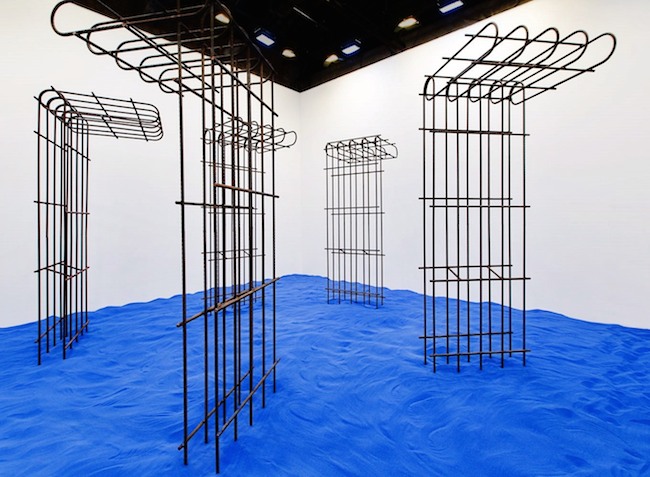
Kosovo at the 56th Venice Biennale
One final thought: there is no single specialist event where Westerners can obtain an overview of East European art.
Ideally what is needed is a Fair devoted exclusively to artists and galleries from across Eastern Europe – combined with a Symposium bringing together East European artists, collectors, galleries, curators and media with their Western counterparts.

